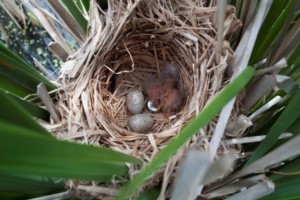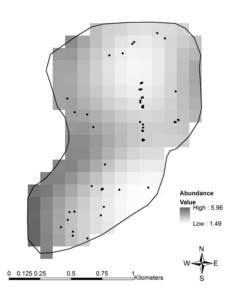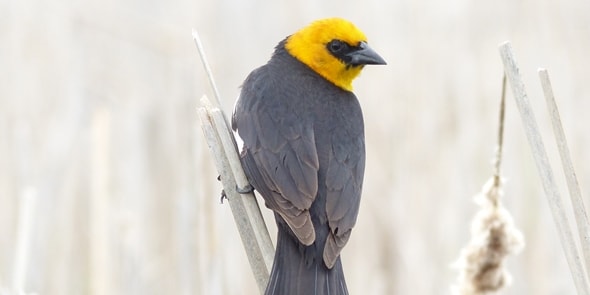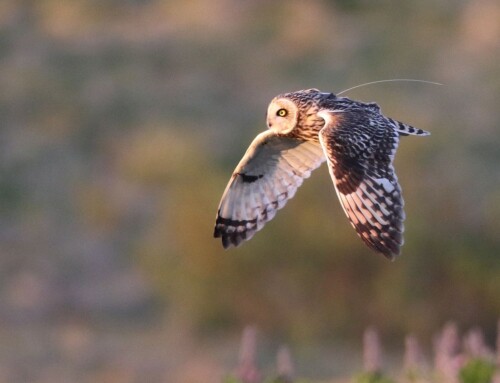In nearly all species, proper care of offspring can drastically increase fitness. Parents must carefully manage time spent away from the nest; foraging bouts away from the nest are critical for collecting resources for themselves, but leaving a nest unattended too long can cool eggs or leave the nest unprotected and at risk of predation. The frequency of their absences is also important, as more activity around their nests may attract attention of predators and thus increase the risk of predation (Skutch 1949).
This constraint on activity may influence nesting behavior, causing parents to leave their nests less often when predators are more abundant despite losing valuable foraging time. It’s currently unknown how plastic parental care is to different levels of predation risk, particularly in species that nest in colonies. As each colony member may defend against an approaching predator, theory suggests that colony-nesters could have their nests partially defended at all times by conspecifics, therefore reducing the overall predation risk even in the presence of an abundant nest predator.

Figure 1 Yellow-headed Blackbird nest with recently hatched chick and temperature data logger at Big Wall Lake, Iowa, USA, 2015
We sought to test this theory using the Yellow-headed Blackbird (Xanthocephalus xanthocephalus), a colony-nesting species, and the Marsh Wren (Cistothorus palustris), an aggressive nest predator. Both species are common in their respective breeding ranges in North America in emergent, freshwater marshes. Marsh Wrens destroy nests and depredate eggs of numerous marsh-nesting species, including those of the Yellow-headed Blackbird, which can account for significant nest failure in this species (Bump 1986). Blackbirds therefore respond aggressively to both visual and audible Marsh Wren’s presence in an effort to protect nests and defend territories (Neudorf et al. 2011).
We examined whether predator density influenced parental nest activity in these two species by asking the question, do Yellow-headed Blackbird parents leave nests more or less frequently (off-bout) as a function of Marsh Wren density? Because each off-bout can draw attention from nest predators, we hypothesized that blackbirds would limit off-bouts when predation risk, or predator density, is high. We conducted gridded point-count surveys to estimate a density surface for both species (Figure 2) and searched for and monitored Yellow-headed Blackbird nests at Big Wall Lake, Iowa, USA. We placed temperature loggers (Figure 1) in 52 monitored blackbird nests to measure when the bird left or returned to the nest using methods established by Walters et al. (2016). We then calculated the number of off-bouts for each nest during four time periods each day: morning (05:00-10:00), day (10:00-16:00), evening (16:00-21:00), and night (21:00-05:00). Blackbirds rarely left their nests at night, so this period was excluded from analysis.

Figure 2 Interpolated density of Marsh Wrens within our study area in relation to nests on which nest temperature was monitored. The solid black line represents the outline of the study area and the black dots represent locations of individual Yellow-headed Blackbird nests at Big Wall Lake, Iowa, USA, 2015
Yellow-headed Blackbirds left their nests less frequently when Marsh Wren density was high during both the morning and evening (Figure 3). This suggests parents alter their nesting strategy depending on potential predation risks to their offspring. Similar results have been found in other species (Conway & Martin 2000, Massaro et al. 2008), indicating that perceived risk from predators can have a strong impact on nest attendance behavior.

Figure 3 Predicted number of off-bouts/h as a function of Marsh Wren density for the morning (Morn), day (Day) and evening (Eve) time period at Big Wall Lake in Iowa, 2015. The solid line, which was created using the linear equation from the model that included Marsh Wren density as the single covariate for each time period, shows the point estimates, and the grey envelope represents the 95% confidence interval
Interestingly, local blackbird density had no significant effect on off-bout frequency. Colonial nesting is thought to have evolved, in part, as a defense against nest predators (Horn 1968, Picman et al. 2002). In this study, the presence of more blackbirds had no significant impact on nest attendance behavior, indicating that colonial nesting may confer less protection in Yellow-headed Blackbirds than previously assumed according to theory.
Read the paper:
Predator density influences nest attendance of Yellow-headed Blackbirds Xanthocephalus xanthocephalus. Behrens, C., Ruff, Z.J., Harms, T.M. & Dinsmore, S.J. 2019. IBIS. VIEW
Nominate this article for a BOU Science Communication Award.
References
Bump, S. 1986. Yellow-headed Blackbird nest defense: aggressive responses to Marsh Wrens. Condor 88: 328–335. VIEW
Conway, C.J. & Martin, T.E. 2000. Evolution of Passerine incubation behavior: influence of food, temperature, and nest predation. Evolution 54: 670–685. VIEW
Horn, H.S. 1968. The adaptive significance of colonial nesting in the Brewer’s Blackbird (Euphagus cyanocephalus). Ecology 49: 682–694. VIEW
Massaro, M., Starling-Windhof, A., Briskie, J.V. & Martin, T.E. 2008. Introduced mammalian predators induce behavioral changes in parental care in an endemic New Zealand bird. PLoS ONE 3: e2331. VIEW
Neudorf, D.L.H., Sears, K.E. & Sealy, S.G. 2011. Responses of nesting Yellow-headed Blackbirds and Yellow Warblers to Wrens. Wilson J. Ornithol. 123: 823–827. VIEW
Picman, J., Pribil, S. & Isabelle, A. 2002. Antipredation value of colonial nesting in Yellow-headed Blackbirds. Auk 119: 461–472. VIEW
Skutch, A.F. 1949. Do tropical birds rear as many young as they can nourish? IBIS 91: 430–455. VIEW
Walters, L.A., Webber, J.A., Jones, B.A. & Volker, C.L. 2016. Taking a break: the relationship between ambient temperature and nest attendance patterns of incubating Carolina Chickadees (Poecile carolinensis). Wilson J. Ornithol. 128: 719–726. VIEW
Image credits
Featured image: Male Yellow-headed Blackbird, Xanthocephalus xanthocephalus © Tyler M. Harms




